Human activity plays a crucial role in global warming and the greenhouse effect, two directly related concepts. Global warming and the greenhouse effect, the main cause of the Earth’s overheating, are not the same thing, which is why it is necessary to know what each of these phenomena is.
What is the greenhouse effect?
The greenhouse effect is the heat that is retained near the Earth’s surface and allows the planet to stay warm. This form of heat conservation occurs naturally thanks to the so-called “greenhouse gases”, which cause the sun’s heat to be retained in the atmosphere and not lost to space in its entirety.
There are different types of greenhouse gases including carbon dioxide, methane, nitrous oxide, hydrofluorocarbons, perfluorocarbons, sulfur hexafluoride, nitrogen trifluoride and water vapor. And each has a function. For example, water vapor, when it comes into contact with other gases, produces a feedback. Meanwhile, as NASA scientists point out, the warming of carbon dioxide balances the heat in the Earth’s atmosphere. However, if CO2 is removed, the greenhouse effect becomes unbalanced and the Earth would therefore cool by about 33°C.
The natural development of the greenhouse effect makes it possible to achieve a viable temperature for life on the planet. However, in recent centuries, humans have interfered with the planet’s energy balance. Mainly, the advent of the industrial revolution and the use of coal-burning machinery, oil, and other gases that raise the levels of carbon dioxide and nitrous oxide have changed this natural development.
Deforestation and the destruction of areas rich in biodiversity, the development of intensive livestock farming, the use of fertilizers containing nitrogen and fluorinated gases and plastic pollution are other causes that have altered the natural greenhouse effect, favoring the momentum of global warming.
What is global warming?
Since the middle of the 18th century, the planet began a transformation in the way we produce and consume that has not stopped. But it was not until the 1950s that the Earth underwent unprecedented changes: the atmosphere and oceans warmed, glaciers began to melt more rapidly, reducing their surface area, and sea levels rose.
Based on various hypotheses developed in 1975 by the American geophysicist Wallance Smith Broecker, it was concluded that there was global warming.
Global warming is a gradual and sustained increase in the Earth’s average temperature over time. This increase in heat has been generated as a result of human activity, which is responsible for emitting most of the gases in the atmosphere inappropriately.
What is the difference between global warming and the greenhouse effect?
The main difference between global warming and the greenhouse effect lies in the origin. The greenhouse effect is a natural phenomenon and beneficial to life on Earth. However, global warming is produced as a consequence of the combustion of fossil gases expelled by industry, livestock, vehicles and other terrestrial elements, which generate an increase in global temperature.
On the other hand, the direct relationship between the two terms must be taken into account. Global warming is the result of overexploitation of the greenhouse effect and, in turn, causes climate change.
Consequences of global warming and the greenhouse effect
The increase in the average temperature of the planet brings with it various conditions and negative effects for life on Earth. Higher temperatures on Earth cause glaciers to melt. Consequently, there is a global rise in sea level, the release of large quantities of methane trapped within the ice sheets.
The melting ice can bring with it a high probability of flooding on islands and coastal cities. Thanks to the use of satellites that began analyzing sea surface height in 1993 with the TOPEX/Poseidon mission, the global average sea level has risen by 9.1 centimeters, as revealed by NASA. The annual rate of rise in 1993 was 0.20 centimeters, and currently stands at 0.44 centimeters. Based on different measurements, the space agency estimates that in 2050 the sea level will reach 0.66 centimeters per year.
On the other hand, a large number of animal species may also be affected, which may be forced to migrate in order to survive, as climate change alters their natural habitat. Global warming has a serious impact on soil degradation processes and favors the desertification of the planet. According to the UN “State of the World’s Soil Resources” report, 33% of the soil is degraded and has lost value.
Likewise, the increase in temperatures and the alteration of seasons have an impact on agriculture and livestock farming, as insects, invasive weeds and diseases proliferate, gradually degrading the quality of production. Not to mention the impact of other natural phenomena such as droughts and torrential rains.
In addition to the problems directly related to the alteration of the planet’s natural assets, the World Health Organization (WHO) states that global warming can cause diseases and infections such as malaria, cholera and dengue fever, among others.








